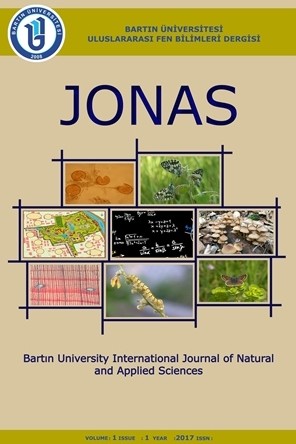THE EFFECT OF PINE TREE RESIN ON THE THERMAL AND MECHANICAL PROPERTIES OF PLASTER WITH EXPANDED CLAY
THE EFFECT OF PINE TREE RESIN ON THE THERMAL AND MECHANICAL PROPERTIES OF PLASTER WITH EXPANDED CLAY
Expanded clay, pine tree resin, gypsum insulation plaster, building material,
___
- 1. ASTM C 109-80. (1983). Standard test method for compressive strength of hydraulic cement mortars, Standards ASTM Designation.
- 2. Bajdur, W., Pajaczkoeska, J., Makarucha, B., Sulkowski, A. & Sulkowski, W.W. (2002). Effective polyelectrolytes synthesized from expanded clay waste. European Polymer Journal, 38, 299-304.
- 3. Bartolini, R., Filippozzi, S., Princi, E., Schenone, C. & Vinici, S. (2010). Acoustic and mechanical properties of expanded clay granulates consolidated by epoxy resin. Applied Clay Science, 48: 460-465.
- 4. Bicer, A. (2020). Thermal Properties of Gypsum Plaster with Fly Ash, International Journal of Eastern Anatolia Science Engineering and Design, 2(1), 120-138.
- 5. Biçer, A. (2021-a). Effect of fly ash and pine tree resin on thermo-mechanical properties of concretes with expanded clay aggregates. Case Studies in Construction Materials, 15 e00624
- 6. Bicer, A. (2021-b). Effect of pine resin on the thermal and mechanical properties of plaster with pumice, Dicle University Journal of Engineering (DUJE), 12 (3), 523-533.
- 7. Bicer, A., (2019). Influence of tragacanth resin on the thermal and mechanical properties of fly ash-cement composites, Journ, al of Adhesion Science and Technology, 33(10), 1019-1032.
- 8. Bicer, A. & Celik, N. (2020). Influence of pine tree resin on thermo-mechanical properties of pumice-cement composites, Cement and Concrete Composites, 112: September, 103668.
- 9. Bouvard, D., Chaix, J.M., Dendievel, R., Fazekas, A., Létang, J.M., Peix, G. & Quenard, D. (2007). Characterization and simulation of microstructure and properties of EC lightweight concrete. Cement and Concrete Research, 37, 1666 -1673.
- 10. BS 812-109 Standards, (1990). Testing aggregates-part 109: methods for determination of moisture content., British Standards Institution.
- 11. Chen, B. & Liu, J. (2004). Properties of lightweight expanded clay concrete reinforced with steel fiber. Cement and Concrete Research, 34, 1259 — 1263.
- 12. Choi, N.W. & Ohama, Y. (2004). Development and testing of polystyrene mortars using waste EC solution-based binders. Construction and Building Materials, 18, 235-241.
- 13. Demirdag, S. & Gunduz, L. (2008). Strength properties of volcanic slag aggregate lightweight concrete for high performance masonry units. Construction and Building Materials, 22, 135–142.
- 14. Denko, S. (1990), Shotherm Operation Manual No 125-2. K.K. Instrument products department, 13-9, Shiba Daimon, Tokyo, 105, Japan.
- 15. Devecioglu, A.G. & Bicer, Y. (2016). The effects of tragacanth addition on the thermal and mechanical properties of light weight concretes mixed with expanded clay. Period. Polytech. Civil Eng., 60(1), 45-50.
- 16. Fakhfakh, E., Hajjaji, W., Medhioub, M., Rocha, F., Lopez-Galindo, A. & Settim, M. (2007). Effects of sand addition on production of lightweight aggregates from Tunisian smectitr-rich clayey rocks. Applied Clay Science, 35, 228-237.
- 17. Gencel, O., Diaz, J.J.C., Sutcu, M., Koksal, Rabanal, F.F.P.A., Barrera, G.M. & Brostow, W. (2014). Properties of gypsum composites containing vermiculite and polypropylene fibers: Numerical and experimental result, Energy and Building, 70, 135–144.
- 18. Gnip, I., Vejelis, S. & Vaitkus, S. (2012). Thermal conductivity of expanded clay (EC) at 10 oC and its conversion to temperatures within interval from 0 to 50 oC. Energy and Buildings, 52, 107-111.
- 19. Kaya, A. & Kar, F. (2016). Properties of concrete containing waste expanded polystyrene and natural resin. Construction and Building Materials, 105, 572-578.
- 20. Miled, K., Sab, K. & Roy, R.L. (2007). Particle size effect on EC lightweight concrete compressive strength: Experimental investigation and modeling. Mechanics of Materials, 39, 222-240.
- 21. Nahhab, A. & Ketab, A.K. (2020). Influence of content and maximum size of light expanded clay aggregate on the fresh, strenght, and durability properties of self-compacting lightweight concrete reinforced with micro steel fibers. Construction and Building Materials, 233, 117922
- 22. Othman, M.L.B., Alsarayreh, A.I.M., Abdullah, R.B., Sarbini, N.N.B., Yassin, M.S.B. & Ahmad, H.B. (2020). Experimental study on lightweight concrete using lightweight expanded clay aggregate (LECA) and expanded perlıte aggregate (EPA). Journal of Engineering Science and Technology, 2020; 1186 – 1201-15(2).
- 23. Rossignolo, J.A., Marcos, V.C. & Jerusa, A. (2003). Properties of high-performance LWAC for precast structures with Brazilian lightweight aggregates. Cement and Concrete Composites, 25, 77-82.
- 24. Subasi, S. (2009). Production of structural lightweight concrete with expanded clay aggregate. J. Fac. Arch. Gazi Univ., 24(3), 559-567.
- 25. TS 699, (2009). The test and experiment methods of natural building stones, TSE, Ankara.
- 26. Vasina, M., Hughes, D.C., Horoshenkov, K.V. & Lapcik, L. (2006). The acoustical properties of consolidated expanded clay granulates. Applied Acoustics, 67(8), 787-796.
- 27. Vysnıauskas, V.V. & Zıkas, A.A. (1988). Determination of the thermal conductivity of ceramics by the Hot-Wire Technique. Heat Transfer Soviet Research, 20 (1), 137-142.
- 28. Xue, F., Takeda, D., Kimura, T. & Minabe, M. (2004). Effect of organic peroxides on the thermal decomposition of expanded clay with the addition of c-methyl styrene. Polymer Degradation and Stability, 83, 461-466.
- Yayın Aralığı: Yılda 2 Sayı
- Başlangıç: 2017
- Yayıncı: Bartın Üniversitesi
PERFORMANCE OF BORON NITRIDE NANOSHEETS IN DYE ADSORPTION: A MINI-REVIEW
STADYUMLARIN KENTTEKİ SOSYAL YAPILANMASININ TÜRKİYE AÇISINDAN DEĞERLENDİRİLMESİ
YABAN HAYATI BESLEMESİ ÜZERİNE BİR DEĞERLENDİRME
Nuri Kaan ÖZKAZANÇ, Burak YİGİT
THE EFFECT OF PINE TREE RESIN ON THE THERMAL AND MECHANICAL PROPERTIES OF PLASTER WITH EXPANDED CLAY
SYNTHESIS AND FUNCTIONAL PROPERTIES OF DIPHENYLAMINE-CONTAINING SCHIFF BASES
Hasan Ufuk CELEBİOGLU, Ebru KÖROĞLU, Recep TAŞ, Sevilay GÜNAY, Yavuz ERDEN
COMPARATİVE ANALYSİS OF THE VİSUAL ELEMENTS OF TRADİTİONAL MOSQUES OVER MODERN MOSQUES
Esma KİŞMİROĞLU, Serhat ANIKTAR
DOMATESTE BULUNAN KAROTENOİDLERDEN OLAN LİKOPENİN PROBİYOTİK BAKTERİLER İLE ETKİLEŞİMLERİ
Ebru KÖROĞLU, Hasan Ufuk CELEBİOGLU
KOMPOZİT ZIRH TASARIMI VE BALİSTİK DİRENCİNİN İNCELENMESİ
